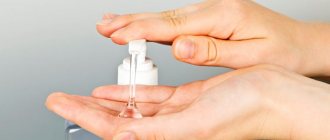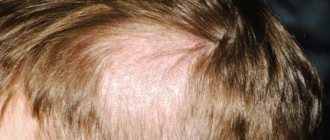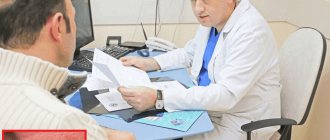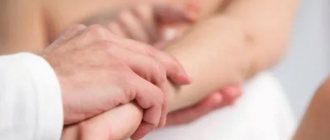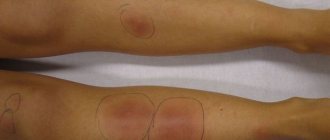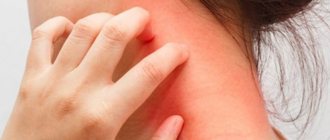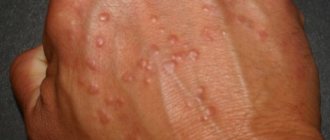YOU MAY ALSO LIKE
Newborn care
Fever in babies and toddlers: recommendations and guidelines for action
The rosy cheeks of a baby usually only cause tenderness. True, sometimes pink cheeks are one of the symptoms of the disease. Fifth disease, or erythema infectiosum, is a viral disease, one of the manifestations of which is a rash on the face of a child. It can be mistaken for blush on the cheeks. As a rule, this disease is not dangerous, but it is worth learning more about it in case your baby becomes infected with it. In this article we will tell you about the fifth disease, its manifestations and symptoms, methods of prevention, and when you need to see a doctor.
What is fifth disease?
Fifth disease is an infectious disease caused by parvovirus B19. Most often it affects children aged 5 to 15 years. This disease is considered mild because children mostly feel well, even if they develop a rash. The medical name is erythema infectiosum, and the phrase “fifth disease” arose because erythema was fifth on the list of six common childhood diseases accompanied by a rash. Here is a list of these diseases:
- measles
- scarlet fever
- rubella
- Infectious mononucleosis
- erythema infectiosum
- roseola infantile (sudden exanthema)
Fortunately, having recovered from the fifth disease, your child will forever acquire immunity to it.
What are the symptoms and manifestations of fifth disease?
The main symptom of fifth disease is a rash. As a rule, it does not appear at the very beginning of the disease, but after a couple of days. First it appears on the face. After a few days, the rash spreads to the child's arms, torso, thighs, buttocks, and feet. In adults, the rash usually does not appear. The rash looks like pink spots that can merge with each other in the form of a kind of “lace”. Elements of the rash can be either true spots (that is, not felt by the fingers), or have edges slightly raised above the skin level. Often such satiety is accompanied by itching, especially severe in the area of the feet. The rash usually goes away within seven to ten days. It sometimes occurs again weeks or months later, often after exposure to sunlight, extreme heat, or extreme cold. At the very beginning of the disease, even before the rash appears, fifth disease can manifest itself with symptoms similar to those of the common cold:
- a sore throat
- headache
- stuffy or runny nose
- redness of the eyes
- weakness
- elevated temperature
- diarrhea
- indigestion
- itching
- enlarged lymph nodes
- joint pain or swelling (hands, wrists, knees, ankles), although this is more common in older children and adults
Types and symptoms
Today, doctors count over 20 types of erythema. Each is characterized by primary and secondary characteristics.
They manifest themselves in patients with different intensities, this is due to the individual characteristics of the body. For example, in some the spots may be pronounced and reach a bright crimson hue, while in others they appear only with a slight pink blush.
- Symptomatic erythema is caused by strong emotions such as fear, embarrassment, and anger. It is short-term in nature and therefore does not require therapy. The process stops on its own when the person calms down.
- Persistent erythema is a rare form of the disease, the etiology of which is not precisely established. However, it is known that the eruption of miniature papules, merging into large areas of inflammation, is caused by unfavorable heredity and infection.
- Ramirez's persistent ashy dermatosis (dyschromic erythema) is distinguished by the color of the lesions, which acquire a grayish tint. The spots go away on their own over time.
- Palmar erythema is a special type of disease that occurs in patients with impaired liver function. It manifests itself as redness of the palms, mainly in the area of elevations under the thumb and little finger.
- Exudative erythema multiforme has frequent relapses and periods of remission. The rashes are located symmetrically on the legs and arms. The affected areas of the skin acquire a bluish tint. The edges of the lips are also involved, on which papules form with the subsequent appearance of bloody crusts. They disappear within a week. The patient's general health deteriorates, and the affected areas experience pain and itching.
- Polymorphic erythema is otherwise called multiforme. This is due to the fact that the affected areas are multiform in nature. They can be covered with papules of nodular rash, vesicles with liquid filling, hemorrhages, which are pinpoint intradermal hemorrhages. This form of the disease is caused by taking certain types of medications and is accompanied by signs of intoxication.
- Physiological erythema is not considered a pathology by doctors, and therefore does not require treatment. In adults, symptoms appear as a result of emotional experiences, a reaction to a sharp change in air temperature. In newborns it is associated with changes in living conditions outside the mother's womb, for example, gastric nutrition.
- Viral erythema is similar to infectious and colds. It manifests itself in children with reduced immunity in the form of a rash, fever, discomfort in the nose and throat, runny nose and headache. Only after 2-3 days do red spots become noticeable on different parts of the body. They soon pass, but the infection penetrates inside the body. Therefore, it is important to diagnose the disease in time and begin therapy.
- Erythema infectiosum is observed in pediatric patients and has a mild course. The cause is parvovirus B19. Symptoms include a pronounced red tint to the cheeks and a lacy rash. Goes away in 14 days. Adults have a hard time with it. The virus poses a danger to pregnant women.
- Erythema Chamera manifests itself with the typical geometry of a butterfly-like rash. The course is mild, typical but mild signs of intoxication are noted. Occurs in patients of all age groups. However, in adults it is accompanied by joint pain and swelling.
- Centrifugal erythema of Biette is a type of erythematosis, which is popularly called lupus erythematosus. A characteristic sign is the localization of redness in the center of the face with stretching to the periphery. Patients are not bothered by itching.
- Centrifugal erythema Daria is manifested by the appearance of round pink spots with a recess in the center of the lesion. The causes of the pathology have not been established, but a viral, bactericidal and fungal nature cannot be ruled out.
- Sunburn. As the name suggests, the cause is prolonged exposure to daylight. The skin in areas free from clothing turns red. In severe cases, the temperature may rise. Pain is noted when touching the affected areas where swelling is noted. Patients are advised to use sunscreens and sprays when going outside at any time of the year.
- Ultraviolet erythema manifests itself in a similar way to the solar form of the disease, however, the cause of skin damage is artificial sources of UV rays - devices, lamps, solariums.
- Fixed erythema can be caused by various types of antibiotics and hormonal medications. When taken, hypersensitive patients develop red spots in strictly defined places. The affected area is the natural folds of the skin, face, and genital area.
- Ring-shaped erythema develops as a result of decreased immunity and hormonal imbalance, and can also be caused by helminthiasis, infections, and oncology. Sometimes a rheumatoid form is observed. Treatment is prescribed after identifying the underlying causes.
- Toxic erythema occurs in newborns and is the result of allergens entering the blood. Hyperemic affected areas are noted. In adults, the causes of development are considered to be exogenous and endogenous factors.
- Erythema nodosum can be caused by various types of microbes, for example, toxoplasmosis, tubercle bacilli, streptococci. A typical sign is multiple or single affected areas localized on the legs, which have a pinkish or bluish tint and hurt, sometimes so severely that the patient cannot move freely.
- Erythema nodosum manifests itself with symptoms similar to the nodular form. Therapy in both cases is carried out in a hospital and involves eliminating the underlying cause.
How long can fifth disease be contagious?
The fifth disease is transmitted to other people within a week from the onset of the disease (that is, the appearance of the first symptoms similar to the manifestations of ARVI) until the appearance of a rash in the child. Once the rash appears, the child is no longer contagious. Just in case, do not allow your baby to come into contact with other people, even when he has a rash, especially if he has a fever. This way the virus will not spread further. If your baby has erythema infectiosum, try to keep him away from pregnant women. If an expectant mother becomes infected with this virus during pregnancy, it can lead to serious problems in the development of the fetus.
Erythema nodosum: what it is, how it manifests itself
Content:
- Erythema nodosum: what it is, how it manifests itself
- Causes and mechanism of development of erythema nodosum
- Course and main symptoms of the disease
- Diagnosis and treatment of erythema nodosum
Erythema nodosum is an inflammatory disease that locally affects the subcutaneous and cutaneous blood vessels. The impetus for its development is an allergic reaction, and erythema itself is a type of allergic vasculitis. Characteristic spherical or hemispherical nodes of various sizes appear on the affected area. Most often, these nodes appear on symmetrical areas of the lower extremities, although sometimes they affect the face and arms.
The disease can develop in a person of any gender and age, but is mainly diagnosed in women aged 20-30 years. For every 4-6 sick women, there is only one man with this pathology. It is believed that the incidence increases slightly in winter and spring. Erythema nodosum occurs in approximately 30-40% of humanity, so it can be called a common disease.
The name of the pathology was first proposed at the beginning of the 19th century by the British dermatologist Robert Willan. Its allergic nature was discovered much later, but before that it was believed that erythema nodosum was an independent specific nosological entity.
Unlike systemic vasculitis, erythema is local and limited in location and does not spread throughout the body.
The appearance of the affected area becomes lumpy, which is due to the somewhat loose, uneven surface of the skin with tubercles.
How can a child become infected with fifth disease?
Erythema infectiosum, like many other viral diseases, is transmitted by airborne droplets, that is, through the ingestion of respiratory secretion products (saliva, sputum, mucus) by virus carriers when sneezing or coughing. Infected people are most contagious when the symptoms of the disease are similar to those of a typical cold. Fifth disease is also transmitted through blood, so pregnant women are advised to avoid sick people, as the pathogen can be transmitted through the blood to the fetus.
What are the means to prevent fifth disease?
There is no vaccine for fifth disease. However, there are several recommendations that you, your family members and your children can follow to reduce the likelihood of infection in the family:
- Wash your hands frequently with soap and water for at least 20 seconds.
- Cover your nose and mouth when sneezing or coughing.
- Avoid touching your face, especially your nose, eyes and mouth.
- Try not to contact potentially infected people.
- If you have fifth disease, stay home and avoid contact with other people to avoid infecting them.
Diagnostic and treatment methods
The primary diagnosis of ring-shaped erythema of the skin is carried out by dermatologists. The doctor will examine the affected areas of the skin and collect anamnesis, after which he will develop an examination program. This may include:
- taking scrapings or smears from the surface of the rings with subsequent laboratory testing - allows you to exclude fungal infections,
- blood tests will help identify hidden inflammatory processes,
- assessment of hormonal levels - if endocrine diseases are suspected,
- tests for allergies to medications, household chemicals, food - a panel of allergens is selected taking into account the patient’s medical history and complaints,
- research to rule out parasite infection.
Based on the results of the initial diagnosis, the dermatologist can develop a therapy program or refer the patient to another specialist. The treatment method depends on the cause of the pathology:
- for bacterial infections, antibiotics and anti-inflammatory drugs are prescribed,
- allergies require taking antihistamines and avoiding contact with the allergen.
For all patients, the doctor can additionally prescribe local remedies that will help relieve swelling and get rid of rashes, forget about pain and itching, and speed up the restoration of the epidermis.
All articles
5% discount Print coupon from our website
Ask your question on the website Get professional advice!
When should you contact a pediatrician?
If your child's condition worsens (for example, a sudden increase in temperature) or if his symptoms do not go away, contact your doctor as soon as possible. In children with weakened immune systems, erythema infectiosum is more severe. If your child has a weakened immune system, it is recommended to consult a pediatrician at the first symptoms of the disease.
With fifth disease, the baby may feel weak. To help him feel better in a few days or weeks, surround your child with care and love. But there is good news - the fifth disease goes away quite quickly, so everything will soon return to normal.
How this article was written The information presented in this article is based on expert advice published by trusted (medical and government) sources such as the American Pediatric Association and the American College of Obstetricians and Gynecologists. A complete list of links to sources used to write this article can be found at the end of the article. The information on this page is not a substitute for professional medical advice. Always consult your doctor for diagnosis and treatment.
